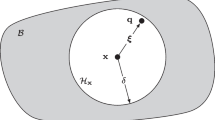Abstract
Pore-scale simulation is increasingly used to study various phenomena that cannot be reproduced by conventional Darcy-based simulators. Direct numerical simulation on systems larger than a few millimeters is too computationally demanding. Pore network modeling (PNM) is a practical way to study the flow at pore scale for a representative elementary volume (REV) in a reasonable time. Pore network models can be divided into dynamic and quasi-static models. Dynamic models explicitly consider the competition between capillary and viscous forces. As they require pressure gradient calculation, they can be computationally expensive. Quasi-static models assume that the flow is only driven by capillary forces and avoids the need for pressure computations. Although they are very computationally efficient, the usage of these models is limited to capillary-dominated flow regimes obtained generally at low capillary numbers. We propose to combine the two approaches in an adaptive model, taking advantage of the speed of a quasi-static algorithm when the flow is governed by capillary forces, and that can simulate viscous effects when they are significant. We propose a criterion to localize the pressure solution in important areas to enhance the computational efficiency of the algorithm even in viscous dominated regimes. In this paper, we first describe our adaptive pore network model. Then, we show that using the capillary number as a switching criterion is not good enough to characterize the domain where the flow is controlled by capillary forces. Therefore, we present a newly defined criterion to switch between the dynamic and quasi-static flow regimes. Finally, we present several test cases where we show that the adaptive algorithm can considerably improve the computational performance of the pore network simulator without losing accuracy of the solution by treating large regions of models with the quasi-static algorithm. For capillary-dominated regimes, the observed speed-up can reach 16,000 for one million-node 3D networks. For viscous dominated regimes, the speed-up can reach 43 for one million-node 3D networks.
Similar content being viewed by others
References
Aghaei, A., Piri, M.: Direct pore-to-core up-scaling of displacement processes: dynamic pore network modeling and experimentation. J. Hydrol. 522, 488–509 (2015)
Al-Gharbi, M.S.: Dynamic pore-scale modelling of two-phase flow. Imperial College (2004)
Cense, A., Berg, S.: The viscous-capillary paradox in 2-phase flow in porous media. In: International Symposium of the Society of Core Analysts held in Noordwijk, The Netherlands, pp. 27–30 (2009)
Dong, H., Blunt, M.J.: Pore-network extraction from micro-computerized-tomography images. Phys. Rev. E 80(3), 036307 (2009)
Joekar-Niasar, V., Hassanizadeh, S.M.: Uniqueness of specific interfacial area–capillary pressure–saturation relationship under non-equilibrium conditions in two-phase porous media flow. Transp. Porous Media 94(2), 465–486 (2012). doi:10.1007/s11242-012-9958-3
Khayrat, K.: Modeling hysteresis for two-phase flow in porous media: from micro to macro scale. Dissertation, ETH-Zürich, 2016, Nr. 23273 (2016)
Lake, L.W.: Enhanced oil recovery (1989)
Lenormand, R., Touboul, E., Zarcone, C.: Numerical models and experiments on immiscible displacements in porous media. J. Fluid Mech. 189, 165–187 (1988)
Loubens, R.D., Vaillant, G., Regaieg, M., Yang, J., Moncorgé, A, Fabbri, C., Darche, G.: Numerical modeling of unstable water floods and tertiary polymer floods into highly viscous oils. In: SPE Reservoir Simulation Conference, Society of Petroleum Engineers (2017)
McDougall, S., Sorbie, K.: The combined effect of capillary and viscous forces on waterflood displacement efficiency in finely laminated porous media. In: SPE Annual Technical Conference and Exhibition, Society of Petroleum Engineers (1993)
McDougall, S.R., Sorbie, K.: The impact of wettability on waterflooding: pore-scale simulation. doi:10.2118/25271-PA (1995)
Regaieg, M.: Pore network modelling of fingering phenomena during unsteady-state waterflooding of heavy oils. Heriot-Watt University (2015)
Regaieg, M., McDougall, S., Bondino, I., Hamon, G.: Finger thickening during extra-heavy oil waterflooding: simulation and interpretation using pore-scale modelling (2014)
Regaieg, M., McDougall, S., Bondino, I., Hamon, G.: Finger thickening during extra-heavy oil waterflooding: simulation and interpretation using pore-scale modelling. PLOS ONE (2017)
Regaieg, M., Moncorge, A.: Improving the computational efficiency of a dynamic pore network model—a hybrid approach for a better performance. In: ECMOR XIV-15th European Conference on the Mathematics of Oil Recovery (2016)
Riaz, A., Tang, G.-Q., Tchelepi, H.A., Kovscek, A.R.: Forced imbibition in natural porous media: comparison between experiments and continuum models. Phys. Rev. E 75(3), 036305 (2007)
Ryazanov, A.V., Van Dijke, M.I.J., Sorbie, K.S.: Two-phase pore-network modelling: existence of oil layers during water invasion. Transp. Porous Media 80(1), 79–99 (2009). doi:10.1007/s11242-009-9345-x
Skauge, A., Ormehaug, P.A., Gurholt, T., Vik, B., Bondino, I., Hamon, G.: 2-D visualisation of unstable waterflood and polymer flood for displacement of heavy oil. In: SPE Improved Oil Recovery Symposium, Society of Petroleum Engineers (2012)
Thompson, K.E.: Pore-scale modeling of fluid transport in disordered fibrous materials. AIChE J. 48(7), 1369–1389 (2002)
Valvatne, P.H., Blunt, M.J.: Predictive pore-scale modeling of two-phase flow in mixed wet media. Water Resour. Res. 40, 7 (2004)
Yang, J., Bondino, I., Regaieg, M., Moncorgé, A.: Pore to pore validation of pore network modelling against micromodel experiment results. Computational Geosciences, pp. 1–14. doi:10.1007/s10596-017-9630-7(2017)
Zhang, C., Oostrom, M., Wietsma, T.W., Grate, J.W., Warner, M.G.: Influence of viscous and capillary forces on immiscible fluid displacement: pore-scale experimental study in a water-wet micromodel demonstrating viscous and capillary fingering. Energy Fuels 25(8), 3493–3505 (2011). doi:10.1021/ef101732k
Acknowledgments
The authors would like to thank the TOTAL management for the authorization to publish this work.
Author information
Authors and Affiliations
Corresponding author
Rights and permissions
About this article
Cite this article
Regaieg, M., Moncorgé, A. Adaptive dynamic/quasi-static pore network model for efficient multiphase flow simulation. Comput Geosci 21, 795–806 (2017). https://doi.org/10.1007/s10596-017-9661-0
Received:
Accepted:
Published:
Issue Date:
DOI: https://doi.org/10.1007/s10596-017-9661-0




